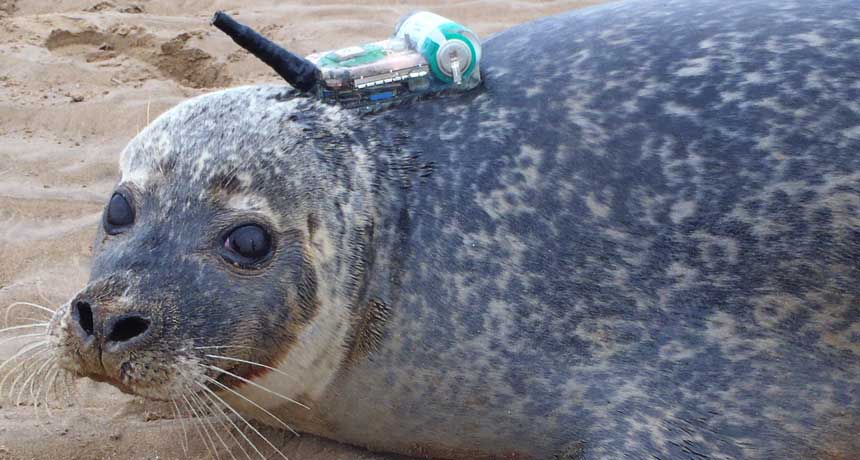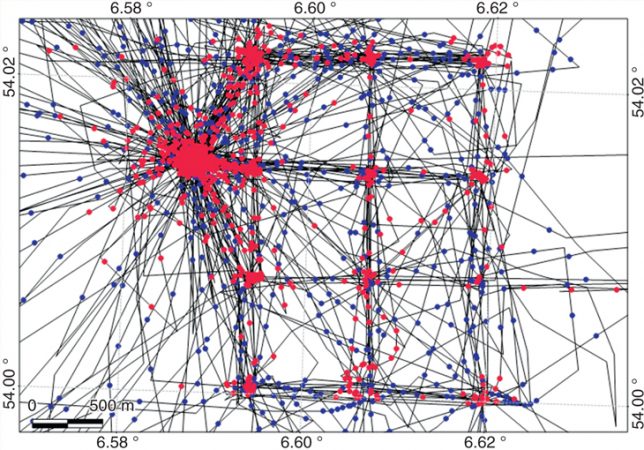Wind farms: Restaurants for seals?
Marine predators may be drawn to the prey that make these artificial reefs their home

Scientists temporarily tagged harbor seals in the North Sea with GPS trackers (one shown on this animal’s head) and found that a few regularly hunt at the base of wind turbines.
D.J.F. Russell et al/Current Biology 2014
Share this:
- Share via email (Opens in new window) Email
- Click to share on Facebook (Opens in new window) Facebook
- Click to share on X (Opens in new window) X
- Click to share on Pinterest (Opens in new window) Pinterest
- Click to share on Reddit (Opens in new window) Reddit
- Share to Google Classroom (Opens in new window) Google Classroom
- Click to print (Opens in new window) Print
In many places around the world, modern windmills harness the power of the wind for energy. These wind turbines can be found even offshore, along the coasts of Europe and Asia. Mussels, crabs and other aquatic life treat the underwater parts of those turbines as artificial reefs. And they, in turn, are drawing in something even bigger. A handful of harbor seals have been spotted hunting at wind farms in European waters, researchers reported July 21 in Current Biology.
The seals “are likely to be eating fish, which are locally concentrated at the artificial reefs,” says Deborah Russell. She is a marine biologist at the University of St. Andrews in Scotland. She also led the new study.
Russell and her colleagues captured and temporarily tagged dozens of harbor and grey seals off of the coast of the North Sea near England and the Netherlands. They fitted each seal with a global positioning system (GPS) tracker and then released the animal. The GPS tracker, a type of tag, let the researchers map where the mammals swam from day to day. The researchers could track when the seals left land. Each animal then spent from several days to a whole month at sea.
Eleven harbor seals visited two offshore wind farms. These farms were Alpha Ventus, off northern Germany, and Sheringham Shoal, off of the southeastern coast of England.
Wind turbines are set up in a grid pattern. Each is placed at regular distances from the others. When three of the 11 seals visited the farms, they followed this grid, moving from one turbine to the next. And they concentrated their time at each turbine, not in the spaces between them.
The movements of the three seals slowed at the bases of the turbines. That indicates they were foraging for food. “It is likely that these structures represent profitable foraging opportunities for those individuals,” Russell says. Those three seals kept coming back to the wind farms. That suggests their hunts had been successful.

The researchers think the 11 seals might be pioneers. The wind farms were relatively new in the area. These seals might have been the ones that were more likely to try out new things. And a few seemed to realize they had hit the jackpot.
“As more wind farms are built, artificial reefs mature and more animals encounter these structures, it is likely their use will increase,” Russell says. Other marine mammals, such as the harbor porpoise, also have been spotted in these areas. They, too, may feed there.
Whether artificial reefs are, overall, good for seals and other sea creatures remains an open question, however. The animals are probably disturbed during the wind farm’s construction. There could be negative consequences from noise pollution or interaction with boats carrying crews to service the turbines, Russell says.
And putting all that fish food in one place, while good for a seal, could be bad for the fish, she says. “This makes them vulnerable to be hoovered up by marine predators.”
Power Words
biology The study of living things. The scientists who study them are known as biologists.
forage To search for something, especially food.
global positioning system Best known by its acronym GPS, this system uses a device to calculate the position of individuals or things (in terms of latitude, longitude and elevation — or altitude) from any place on the ground or in the air. The device does this by comparing how long it takes signals from different satellites to reach it.
grid (in mathematics or mapping) A network of lines that cross each other at regular intervals, forming boxes or rectangles, or an orderly field of dots that mark where each pair of lines intersect (cross one another).
hoover A colloquial term for vacuum cleaner. So “to hoover” would be to vacuum something up. The term reflects Hoover having been a famous, early brand in vacuum technology.
mammal A warm-blooded animal distinguished by the possession of hair or fur, the secretion of milk by females for feeding the young, and (typically) the bearing of live young.
marine Having to do with the ocean world or environment.
predator A creature that preys on other animals for most or all of its food.
prey Animal species eaten by others.
reef A ridge of rock, coral or sand. It rises up from the seafloor and may come to just above or just under the water’s surface.
turbine A device with extended arm-like blades (often curved) to catch a moving fluid — anything from a gas or steam to water — and then convert the energy in that movement into rotary motion. Often that rotary motion will drive a system to generate electricity.
wind turbine A wind-powered device — similar to the type used to mill grain (windmills) long ago — used to generate electricity.







